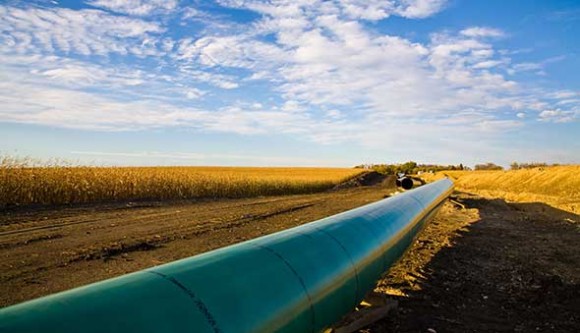
New Managing Director for Bellona Norway
The Board of the Bellona Foundation has appointed former Minister of Climate and the Environment Sveinung Rotevatn as Managing Director of Bellona No...
News

Publish date: February 8, 2017
News
The US Army Corps of Engineers Tuesday decided to grant a final permit for the controversial Dakota Access pipeline after an order from the Trump administration to expedite its permit.
A court filing submitted by the Army represents the first concrete challenge to American commitments to mitigating climate change, and the pipeline could begin operation as soon as June.
The Army corps had previously backed off the project in December after thousands had joined protests by the Standing Rock Sioux tribe, who say the pipeline will tread across ancestral lands and threaten their water supply.
The so-called easement to resume building the 1,885 kilometer pipeline, which will run from shale fields in North Dakota to refineries on the Gulf of Mexico, is the first of two pipeline projects enjoying reinvigoration by Trump, threatening serious damage to US climate commitments reached in the Paris Agreement of 2015.
The second is the Keystone XL pipeline, which Trump has also raised from the grave and green lighted. That pipeline, which would run from the carbon intensive tar sands oil projects in Alberta, Canada, and again to the Gulf of Mexico, was halted by the Obama Administration over the climate damage that would result of bringing the tar sands to market.
 Pipes for Keystone XL construction. (Photo: Wikipedia)
Pipes for Keystone XL construction. (Photo: Wikipedia)
It’s been jokingly suggested that the Dakota Access pipeline posed less of a threat to the global climate than the Keystone XL, but that can’t really be determined yet because the Army Corps hasn’t performed an environmental impact study. In any event, the oil it will bring to market cause the same damage as would 30 coal burning plants.
It also represents a stark break with the Obama administration’s policy of moving cautiously where questions of impact to the climate are concerned. Slated to move 470,000 barrels of oil a day, the pipeline contributes to maintaining a carbon intensive economy when smarter markets are moving toward renewables.
It likewise offers an insulting rejoinder to Native American tribes who have been protesting it. Running the pipeline under the Missouri River, as planned, endangers the tribes’ drinking water in the event of a rupture, and poses a danger of downstream contamination. The pipeline also opens social wounds afresh: It’s hard not to regard the pipeline as later-day federal land grab from indigenous populations.
By nudging the project along, the Trump White House highlights its blunt disregard for ethics as well: Trump reportedly holds or held up to $1 million in shares in Energy Transfer Partners, but since he refuses to release his federal tax returns, there’s now way to objectively establish that.
Even if he has dumped the stock, the pipeline project is still pure patronage – Kelcy Warren, CEO of Energy Transfer Partners, was a major contributor to Trump’s campaign.
The Dakota Access project bulldozes the way for the resurrected Keystone XL pipeline, but its fate is less certain. Trump’s order to complete that project came with a promise to “renegotiate” the terms of the 1,897 kilometer pipeline with Canada so that only American steel is used for its construction.
TransCanada, the company responsible for building it, has yet to indicate whether it will accept those terms. The company had originally planned to build 45 percent of the pipeline with Canadian steel.
But the Keystone XL’s threat to the climate is obvious. Analysis suggests that, once the pipeline is complete, it will move enough climate-volatile tar sands oil to pump 181 million tons of greenhouse gasses into the atmosphere each year, or the pollution equivalent to that put out by 37.7 million new cars on the road each year.
More generally, the Trump administration is aligning to assail Obama’s signature Clean Power Plan limiting emissions from power plants, which has long been tied up in court proceedings, but which also draws its force from a long established law called the Clean Air Act of 1970. That law imparts to the Environmental Protection Agency the right to say greenhouse gases are, in fact, harmful and subject to regulation.
Any challenges to the Clean Power Plan will certainly end up in the US court system, a system to which Trump is already openly hostile. A review of his Twitter insults toward the judges reviewing his precipitous Muslim ban is sufficient to illustrate his tendency toward judicial intimidation.
Trump’s reanimation of two damaging pipeline projects will have baleful consequences for the world climate. But the method he used to do it – executive orders – are easy ways for him to jeer and bear his teeth at the environmental movement and the pipeline protestors who have already taken to the streets.
Dismantling matters of law, like the Clean Air Act, would take a willing judicial branch. The more he mocks judges over his Muslim ban – and he shows no signs of running out of taunts – the less likely other judges will be to cooperate in his project.

The Board of the Bellona Foundation has appointed former Minister of Climate and the Environment Sveinung Rotevatn as Managing Director of Bellona No...

Økokrim, Norway’s authority for investigating and prosecuting economic and environmental crime, has imposed a record fine on Equinor following a comp...

Our op-ed originally appeared in The Moscow Times. For more than three decades, Russia has been burdened with the remains of the Soviet ...

The United Nation’s COP30 global climate negotiations in Belém, Brazil ended this weekend with a watered-down resolution that failed to halt deforest...